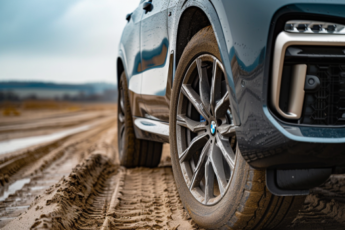Last Updated on 4 weeks
Evaluating Snow Tires on High-Performance Cars in Winter
Winter driving is a challenge for all types of vehicles, but high-performance sports cars like the Corvette and Porsche face unique difficulties in snowy conditions. These sleek, powerful machines are built for speed and agility, but icy roads can hamper their performance. One solution to this problem is equipping your sports car with snow tires. In this article, we will examine the incredible transformation these cars undergo when fitted with snow tires, using a snow tire test to reveal the true power of winter tires on two iconic automobiles.
Key Takeaways
- High-performance vehicles like Corvettes and Porsches can benefit from snow tires during winter driving.
- Snow tires enhance traction, allowing for better control and handling in snowy and icy conditions.
- Proper installation of snow tires is crucial to ensure optimal performance and safety.
- Testing snow tires on a Corvette and a Porsche will help showcase the benefits and limitations of winter tires for high-performance sports cars.
- Understanding the science behind snow tire technology can help drivers make informed decisions when choosing between snow and all-season tires.
- Investing in snow tires can be cost-effective when considering the improvement in safety and handling they provide during winter driving.
- Driver feedback on handling changes can provide valuable insight into the effectiveness of snow tires on high-end sports cars.
The Critical Importance of Snow Tires on High-Performance Vehicles
When it comes to high-performance sports cars, there is often a misconception that they’re unsuitable for winter driving. Many drivers avoid taking their prized vehicles out in snowy or icy conditions. However, equipping high-performance cars like sedans, SUVs, and compact vehicles with snow or winter tires can significantly improve their safety and performance on winter roads.
Driving with snow tires offers a range of benefits, including enhanced traction, more effective control, and shorter stopping distances. These qualities are critical for navigating winter roads safely and ensuring optimal handling of high-performance vehicles, even in poor conditions.
“It’s crucial for sports car drivers to swap their regular tires for snow tires before the arrival of winter. The increased traction and road grip can make a huge difference in terms of safety and control on snowy roads.”
- Enhanced traction – Snow tires provide better traction than all-season tires on icy and snowy surfaces. This improved grip means better control and handling when cornering, accelerating, or braking in winter.
- Improved stopping distances – Snow tires are designed with compounds and treads that target maximum grip on slick surfaces, significantly reducing stopping distances compared to all-season tires.
- Safe winter driving – The combination of better traction, control, and stopping distances boosts driver confidence and overall safety during winter.
Besides these advantages, it’s essential to consider the compatibility of snow tires with your specific high-performance vehicle model. To illustrate this, let’s take a look at a comparison between two popular snow tires for cars.
| Brand | Tread Pattern | Traction | Stopping Distance |
|---|---|---|---|
| Michelin X-Ice Xi3 | High-density 3D sipes | Excellent grip on ice and snow | Short stopping distances |
| Bridgestone Blizzak WS80 | Directional tread pattern with 3D zigzag sipes | Superb traction in all winter conditions | Exceptional stopping performance on ice |
In conclusion, the importance of snow tires on high-performance vehicles cannot be overstated. By fitting your sports car with the right snow tires, you can safely enjoy driving it year-round, reaping the rewards of superior traction and control, even on icy and snowy roads. Consult a tire professional to find the best-suited snow tires for your car and experience enhanced winter driving firsthand.
Deciphering the Science Behind Snow Tire Technology
Understanding the science behind snow tire technology allows drivers to appreciate the advantages of using winter tires, especially in challenging road conditions. This section will explore the unique rubber compounds, tread patterns, and design variations contributing to enhanced tire grip and performance in winter weather.
The Rubber Compounds That Make Winter Tires Special
Flexible rubber is at the core of what sets snow tires apart from all-season alternatives. Winter tires boast a special rubber compound that maintains flexibility even in cold temperatures. This flexibility contributes to exceptional grip and control on icy roads, which is critical for maintaining safety and maneuverability in snowy conditions.
Unique Tread Patterns for Maximum Grip in Snow
Snow tire design incorporates specific tread patterns engineered to provide maximum traction in winter situations. These patterns include deep grooves and sipes – tiny slits within the tire – which enable the tire to bite into snow and ice effectively. This translates into increased grip, skid prevention, and slush expulsion, ultimately improving performance on snowy roads.
Studded vs Non-Studded Snow Tires: A Comparison
There are two primary categories of snow tires: studded and non-studded. Here’s a brief comparison to help you understand their differences and make an educated decision based on your winter road conditions and local regulations:
| Studded Snow Tires | Non-Studded Snow Tires | |
|---|---|---|
| Traction | Use metal studs for additional grip on ice | Depend on rubber compounds and tread design for grip |
| Road Conditions | Best suited for icy road conditions | Effective on snow, ice, and wet roads |
| Regulations | Restricted or prohibited in some areas | Allowed in most regions |
| Road Wear | It can cause increased wear on paved roads | Minimal impact on paved surfaces |
To optimize your vehicle’s performance and safety in winter conditions, it’s crucial to choose the proper snow tire based on your typical driving conditions and any local restrictions on studded tire use. Remember, investing in the right snow tire technology can significantly improve your vehicle’s handling, stability, and overall safety throughout the year’s coldest months.
Pre-Test Analysis: Setting Expectations for the Corvette and Porsche
Before conducting snow tire tests on high-performance vehicles like the Corvette and Porsche, it is crucial to establish performance expectations and prepare for potential challenges inherent to these vehicles in winter conditions. As two popular high-performance vehicles, the Corvette Grand Sport and Porsche 911 are known for their impressive capabilities but also have their own set of potential reliability issues during winter.
By evaluating the performance of these vehicles on snow tires, our goal is not just to assess the impact of winter tires on vehicle handling and stability but also to gain valuable insights into the potential improvement in the cars’ overall reliability in winter conditions.
Winter Tire Performance Metrics
- Acceleration in snow and ice
- Braking distance on snowy surfaces
- Cornering and handling in winter conditions
- Overall vehicle stability and traction
These performance metrics provide a solid foundation for gauging the effectiveness of snow tires on both the Corvette and Porsche. Considering that these vehicles are built with different specifications tailored to their unique performance characteristics is essential. Therefore, it is necessary to set realistic expectations for each car.
| Vehicle | Acceleration (0-60mph) | Braking Distance (60-0mph) | Cornering Grip |
|---|---|---|---|
| Corvette Grand Sport | 3.9 seconds | 96 feet | 1.18g |
| Porsche 911 Carrera | 3.5 seconds | 98 feet | 1.08g |
The table above shows that the Corvette has a slightly superior cornering grip compared to the Porsche, while the Porsche excels in acceleration. This variation in performance characteristics is a valuable reference point for anticipating how these vehicles will perform in the snow tire test.
In conclusion, establishing accurate performance expectations for the Corvette and Porsche will enable a thorough evaluation of the snow tires’ impact on these high-performance vehicles, allowing us to understand better their potential to ensure safety and reliability in harsh winter conditions. The test results will provide valuable insights into how various snow tire features can enhance the driving experience of high-end sports cars and SUVs during winter.
Installation and Safety: Mounting Snow Tires Properly
The importance of proper snow tire installation cannot be overstated, as it directly impacts winter road safety and the effectiveness of your snow tires. Through safe tire mounting and adequate snow tire fitment, drivers can confidently tackle winter’s challenges, whether they are navigating snowy streets with a compact car or traversing icy roads with a truck equipped with snow tires for trucks.
To achieve the best possible tire performance and safety on snowy roads, you must ensure your snow tires are correctly installed on your vehicle. Here are some critical steps to follow during the installation process:
- Select the right size of snow tires for your vehicle. Check the owner’s manual or consult a professional tire specialist for recommendations.
- Always install snow tires in four sets to maintain consistent traction and handling.
- Ensure your snow tires are adequately balanced during installation to avoid uneven wear and potential handling issues.
- Regularly check the air pressure in your snow tires and inflate them according to the manufacturer’s recommendations.
- Rotate your snow tires regularly to ensure even wear and prolong their lifespan.
Following these crucial steps will guarantee a safe and effective snow tire fitment, allowing you to maximize winter road safety and driving efficiency.
“Proper installation and maintenance of your snow tires is the key to getting the most out of them, both in terms of safety and performance.”
The table below summarizes the main aspects to consider when installing and maintaining snow tires, emphasizing the importance of a proper fitment and regular maintenance schedule.
| Aspect | Consideration |
|---|---|
| Tire Size | Choose the correct tire size based on your vehicle’s specifications. |
| Installation | Install a complete set of four snow tires and have them properly balanced. |
| Air Pressure | Regularly check the air pressure and adjust it according to the manufacturer’s guidelines. |
| Rotation | Rotate your snow tires periodically to ensure even wear and extend their lifespan. |
| Maintenance | Inspect your snow tires for irregular wear or damage and replace them as necessary. |
By paying close attention to the installation and maintenance of your snow tires, you can optimize their performance and reap the full benefits of safe and effective winter driving.
Performing the Test: A Tale of Two Cars on Winter Roads
Testing snow tires on a Corvette and a Porsche involves preparing track conditions to mimic winter roads realistically. It ensures the test results accurately reflect the snow tires’ performance in typical winter driving scenarios instead of comparing them with all-season snow tires under ordinary circumstances.
Track Conditions and Preparation
Before beginning the test, track conditions and surfaces were carefully prepared to simulate realistic winter road scenarios that drivers might encounter while using winter tires for cars. This involved creating a mixture of snow, ice, and slush to comprehensively analyze snow tire performance across varying winter roads.
- Icy surfaces for traction evaluation
- Snow-covered tracks for speed testing and vehicle control assessment
- Slushy areas to test the handling on wet, slippery surfaces
Measuring Performance: Speed, Traction, and Control
An unbiased approach was taken to compare the Corvette and Porsche’s performance with snow tires vs all-season tires on winter roads. Key factors, such as speed, traction, and control, were considered and measured to determine the effectiveness of snow tires in enhancing the drivability of high-performance sports cars. Performance on the icy track, snow-covered track, and slushy surface were all considered to carry out a comprehensive snow tire evaluation.
| Test Parameter | Assessment Criteria |
|---|---|
| Speed | Acceleration and deceleration rates when driving on various winter road surfaces |
| Traction | Ability to maintain grip on icy, snowy, and slushy surfaces during straight-line driving and turns |
| Control | Handling stability when encountering different winter road conditions and sudden direction changes |
Note: Data was collected and analyzed to ensure performance measurement and comparison accuracy between the two high-performance sports cars.
In conclusion, testing snow tires on high-performance sports cars like the Corvette and the Porsche is crucial for drivers to understand their benefits and effectiveness in winter road conditions. By preparing tracks that simulate various winter road scenarios and measuring the performance of critical factors such as speed, traction, and control, this test ensures the accuracy and relevance of snow tire evaluation compared to all-season snow tires.
Snow Tires vs. All-Season Tires: A Side-by-Side Evaluation

When it comes to winter driving safety, selecting the right tires for your vehicle is essential. A comparative evaluation between snow tires and all-season tires can help drivers make informed decisions based on performance, cost, and situational advantages. Let’s look at the similarities and differences between snow and all-season tires.
The table below provides a side-by-side comparison of snow tires and all-season tires on critical aspects, including traction, tread design, cost, and performance:
| Aspect | Snow Tires | All-Season Tires |
|---|---|---|
| Traction on Snow and Ice | Superior traction on snow, slush, and ice due to specialized rubber compounds and tread patterns | Offers moderate traction but may struggle in deep snow and icy conditions |
| Tread Design | Features deep grooves and sipes for maximum grip and skid prevention, explicitly designed for winter driving | A compromise between summer and winter tire designs, aimed for versatility but not optimal on snow or ice |
| Cost | It may require an additional investment, as they are designed specifically for winter conditions. | Less expensive due to their versatile nature and ability to handle different seasons without tire change |
| Performance in Non-Winter Conditions | They are not recommended for use in warm weather, as they wear faster and provide decreased performance on dry roads. | Performs well in various conditions, making them a convenient choice for year-round use |
| Winter Driving Safety | Offers increased safety and handling performance on snowy and icy roads, minimizing the risk of accidents. | It provides adequate safety but doesn’t perform as well as snow tires in harsh winter conditions |
While all-season tires balance summer and winter performance, they may not perform as well as dedicated snow tires in severe winter conditions. Consider your typical winter driving conditions and the importance of tire performance on snowy and icy roads before deciding.
“The difference between a snow tire and an all-season tire is like the difference between a hiking boot and an all-purpose athletic shoe.”
Ultimately, your choice of tires depends on your driving conditions’ specific needs and demands. Investing in dedicated snow tires can significantly improve your winter driving safety and vehicle handling if you live in an area with harsh winters and regularly encounter snow, slush, and ice. On the other hand, if you experience mild winters with occasional snow and ice, all-season tires may be a more cost-effective and convenient option.
From Sports to Winter Wonders: Handling and Driver Feedback
Driver feedback is critical to understanding the impact of snow tire handling enhancement on high-end sports cars like the Corvette and Porsche. When equipped with winter tires for sports cars, these high-performance vehicles showcase noticeable handling improvement, transforming them into winter wonders and significantly increasing their versatility and safety on icy roads.
The installation of winter tires on sports cars, especially those with rear-wheel drive, is well-known to improve grip on snowy and icy surfaces. Drivers have often reported feeling more confident and in control when driving under harsh winter conditions. The following are some key takeaways from driver feedback:
- Improved traction and grip: Winter tires offer substantially better traction on snow and ice when compared to all-season tires, allowing sports car drivers to experience greater control and stability.
- Reduced braking distances: Snow tires can reduce braking distances on slippery surfaces, providing sports car drivers with a crucial safety advantage in winter.
- Enhanced vehicle control: Drivers have found winter tires to increase a sports car’s responsiveness and agility, particularly when cornering on icy roads.
Finding suitable winter tires that complement the unique characteristics of high-end sports cars is essential to optimizing their winter performance. Several leading tire manufacturers specialize in developing winter tires for sports cars, delivering both high-quality construction and advanced snow tire technology.
“I never thought I could drive my Porsche confidently in the snow. With the right set of winter tires, it felt like a completely different car – I felt more in control and sure-footed on icy and snowy roads.” – Michael, Porsche 911 Owner
It is important to note that the benefits of winter tires extend beyond their performance on snow and ice. Drivers have often reported improved ride quality, minimized road noise, and enhanced comfort levels when driving with snow tires. These factors are critical for sports car enthusiasts who demand an enjoyable driving experience even during colder months.
In conclusion, winter tires for sports cars provide an undeniable handling improvement and enhance driver feedback, acting as a safety net for sports car enthusiasts venturing out on slippery winter roads. Investing in high-quality snow tires not only expands the capabilities of these high-performance cars but also helps protect both the vehicle and its occupants when temperatures drop.
Cost-Effectiveness and Value: Are Snow Tires Worth the Investment?

When evaluating the cost-effectiveness of snow tires, the focus should be on the balance between the value of winter tires, the initial snow tires cost, and their maintenance expenses. Moreover, exploring the additional benefits offered by winter tires, such as improved safety and better handling in winter conditions, is crucial. This section will discuss the factors that play a role in determining your vehicle’s overall worth of a snow tire investment.
One of the primary arguments favoring investing in snow tires is the improved safety they offer during winter. Compared to all-season tires, winter tires provide enhanced traction and significantly reduce braking distances, thus ensuring a safer driving experience. So, investing in snow tires should be a priority if you prioritize safety.
“The added safety and control provided by snow tires dramatically outweigh their cost, ultimately making them a wise investment for those who frequently drive in winter conditions.”
Another point to consider is your high-performance vehicle’s improved handling and overall performance while using snow tires. A worthwhile winter tire value comes from the increased grip and control in wintery conditions that contribute to a smoother and more enjoyable driving experience. Consequently, the snow tires enable you to utilize the full potential of your high-end sports car in the winter months.
However, the cost of snow tires can be a point of concern. The initial purchase price and proper installation, storage, and maintenance expenses should also be considered as part of the overall snow tire investment. To give you an idea, let’s break down some of the costs involved:
| Expense | Estimated Cost |
|---|---|
| Set of 4 snow tires | $300 – $800 |
| Professional tire installation | $60 – $150 |
| Tire storage (per season) | $50 – $100 |
| Seasonal tire changes | $60 – $100 (per change) |
Although these costs can add up, weighing them against the potential long-term gains in safety, performance, and overall satisfaction is essential. Consider the following benefits of snow tires:
- Improved safety and reduced risk of accidents
- Enhanced vehicle handling in snow and ice
- Extended lifespan of your all-season tires
- Increased resale value of your vehicle
In conclusion, although snow tires demand an initial investment and ongoing maintenance expenses, their benefits in terms of safety, handling, and overall driving experience during winter months make them a valuable addition to your high-performance vehicle. The key is to balance the factors that matter most to you and how the value of winter tires aligns with your priorities and budget.
Conclusion: The Verdict on Snow Tires for High-End Sports Cars
The investigation into the use of snow tires on high-performance vehicles such as Corvettes and Porsches has brought to light valuable insights into High-Performance Vehicle Safety, Winter Tire Conclusion, Snow Tire Benefits, and Performance Cars in Snow. These insights allow drivers of these high-end sports cars to make informed decisions regarding their tire choices during winter conditions.
Combining evidence from the test drives and expert thoughts on technology, handling, and cost-effectiveness, it is clear that snow tires can transform high-performance sports cars, enabling them to navigate snowy and icy roads with increased safety and confidence. The enhanced flexibility, grip, and control provided by the unique rubber compounds and tread designs of snow tires significantly improve performance during winter months, providing greater versatility to drivers.
Additionally, the investment in snow tires proves more cost-effective when considering the potential risks of driving high-performance sports cars on ill-suited all-season tires in winter conditions.
Furthermore, advancements in snow tire technology have made it even more competitive and valuable in helping maintain control and safety in treacherous winter conditions.
In summary, the verdict on snow tires for high-end sports cars is clear—they are a valuable and advantageous investment for those seeking enhanced safety and performance throughout winter.
FAQ
What makes snow tires ideal for high-performance vehicles like the Corvette and Porsche?
Snow tires offer enhanced traction, deep tread patterns, and reduced stopping distances. They provide better control and handling in winter conditions, making them crucial for high-performance vehicles like sedans, SUVs, and compact cars when navigating snowy and icy roads.
How do the rubber compounds in winter tires work in cold temperatures?
The unique rubber compounds in snow tires are designed to remain flexible even in very low temperatures, contributing to the enhanced grip and control they offer on icy roads.
What are the critical differences between studded and non-studded snow tires?
Studded snow tires utilize metal studs to provide additional traction on ice, whereas non-studded snow tires rely on their rubber compounds and tread designs to grip winter roads. The choice between the two types depends on typical winter road conditions and local regulations concerning studs.
How necessary is the proper installation of snow tires?
Proper installation of snow tires is crucial for ensuring safety and effectiveness on snow-covered roads. Proper fitment allows drivers to navigate confidently through winter’s challenges.
How can a snow tire’s performance be measured?
Performance metrics such as speed, traction, and control are key factors to consider when determining the effectiveness of snow tires in enhancing the winter drivability of high-performance sports cars.
How do snow tires compare to all-season tires for winter driving?
Snow tires offer better grip and handling than all-season tires in snowy and icy conditions. By comparing the costs, performance, and situational advantages of both tire types, drivers can make informed decisions regarding their tire choices during winter conditions.
Are snow tires a worthwhile investment for high-end sports cars?
Determining whether snow tires are worth investment involves balancing factors like improved safety, better vehicle handling and the costs associated with purchasing and maintaining these tires. This decision ultimately depends on individual drivers’ specific needs and preferences and the winter driving conditions they regularly encounter.











